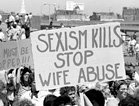Domestic Violence: A History of Reform and Activism in the United States

Family violence has a long history in America. Caught up in social norms about the ideal family, male privilege, and marital privacy, domestic violence has been a persistent problem in American families. Taken up by religious communities, alcohol temperance leaders, feminists, lawyers and social workers, the issue finally established permanent, official recognition as a social and public health concern in the late 20th century. Using interdisciplinary sources that can be tailored to different courses and subject areas, Domestic Violence: A History of Reform and Activism in the United States helps students gain a deeper understanding of domestic violence in the United States. By examining the history of the social, legal, and medical responses to violence against women in the late 20th century—with a special focus on reformers and feminist activists—students will learn how spousal abuse moved out of the shadows and into public activism, medical discourse, and legislation.
The module consists of four one-hour classes, and each class makes use of primary and secondary sources, as well as online resources. Class discussions and activities are an integral part of this module’s success in the classroom. While individual class topics in this module may be used effectively, it is designed to give students a chronological knowledge of the history of domestic violence that culminates with current information about reform efforts, educational outreach, and other resources.
Note to Instructors: Discussing sensitive topics such as domestic violence may be difficult for some students, particularly those who have experienced violence in their homes as children or adults. It is highly recommended that the instructor provide students with the phone number and contact information for the campus counseling center and local domestic violence services.
The first class studies the history of family violence in America from colonial times to the 1960s, with an emphasis on concepts of privacy and the patriarchal family structure, attempts at lawmaking, and the beginnings of women’s organized activism against violence in the home.
The second class looks at the late 20th-century history of how women’s political activism came to include protection and support for battered women in the form of shelters, clinics, and other support services.
The third class explores how legislation, community response, and media exposure in the late 20th century all contributed to cultural and social changes around the issue of domestic violence.
The last class examines how nurses, doctors, and emergency room personnel across the nation studied, shared knowledge, and formed best practices regarding family violence.

